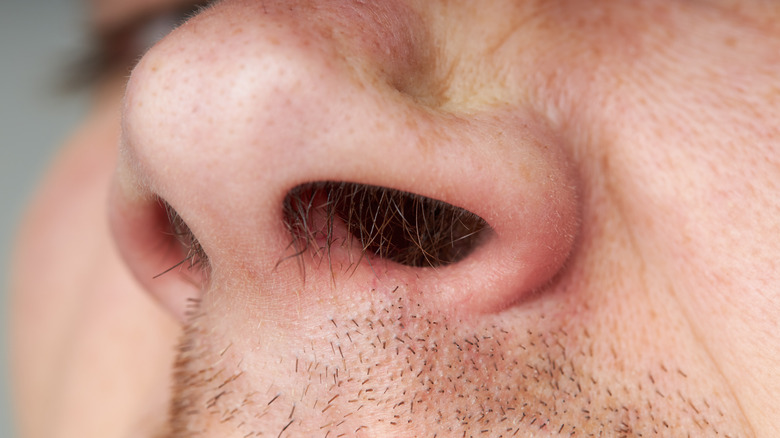Aging Has An Unexpected Effect On Your Nose
The physical effects of aging entail a lot more than just graying hair or the appearance of wrinkles. Rather, our body undergoes numerous changes as we grow older, some more obvious and some barely perceptible. For example, we lose height as our spine progressively shortens, our pupils' reaction time to light slows, and our perception of sweet and salty tastes becomes diminished (via Merck Manual). Everything — from the toenails on our feet to the hair follicles atop our head — is affected. The same is true for our nose. More specifically, our nose hairs.
Think of a warm summer breeze coming in through an open window. You get to enjoy the smell of fresh air while the mesh window screen successfully keeps bugs, dirt, and other unwanted contaminants from making their way into the house. That's not dissimilar to how our nose hairs function. Covered in mucus, our nose hairs help trap contaminants to prevent them from entering our lower respiratory tract. The hairs in our nose are called terminal hairs, explains Nebraska Medicine. As we age, these terminal hairs undergo changes in the growth cycle. As a result, you may notice long, wiry hairs beginning to peek out of your nostrils.
Your nose hairs spend more time in the growth phase as you age
When our hair is actively growing, it's in what's known as the anagen phase (via BBC Science Focus). That growth then comes to a stop in the catagen phase, and the hair remains at rest in what's called the telogen phase until the cycle begins all over again. Testosterone is a major contributing factor in the growth of terminal hairs, such as those inside our nose (per Nebraska Medicine). As we grow older, the accumulation of testosterone in the body can prolong the amount of time our hair stays in the growth phase, explains The New York Times. This process is called anagen sensitivity, reports the Cleveland Clinic. That's what makes those scraggly nose hairs grow unexpectedly long.
"Testosterone primes or changes the hair bulb," endocrinologist Dr. Bradley Anawalt told The New York Times. Potentially beginning as early as one's 40s, men, in particular, may begin to notice these changes in their terminal hairs. This growth may not only occur inside the nostrils, but also in other places (such as on the nose itself).
Other ways aging changes our nose
If you find terminal hairs bothersome, there are safe methods of removal that you can try. Cleveland Clinic experts suggest shortening one's nose hairs with grooming scissors, as the blades are rounded in order to prevent injury. Alternatively, you can also use an electronic nose hair trimmer to get the job done. Whatever you do, avoid ripping out nose hairs at the root. In other words, you don't want to pluck or wax your nose hairs, as this increases your risk of infection and potentially painful ingrown hairs.
However, the lengthening of nose hairs isn't the only unexpected change we may experience in our noses as birthdays roll by. Experts at Merck Manual note that as we age, our sense of smell begins to dwindle due to the gradual thinning and drying out of the inner lining of our nose and the breakdown of nerves. While this effect is relatively minor, it can impact our sense of taste, and you may begin to perceive more foods as bitter or flavorless. The shape of our nose also begins to change as we transition into older adulthood. The organ often grows in size and elongates, and the tip of the nose starts to sag.



